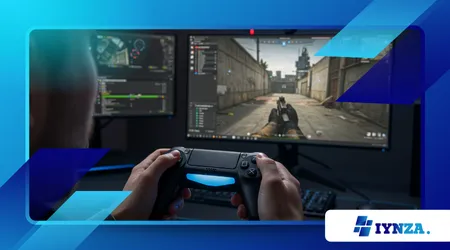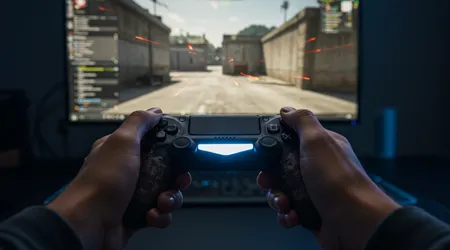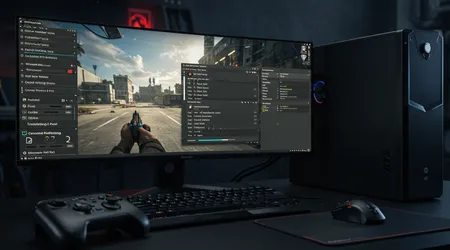Top Controller Settings for Competitive FPS Players

The relentless pursuit of marginal gains separates casual gamers from elite competitors in the highly competitive FPS arena.
Anúncios
Achieving pixel-perfect accuracy and lightning-fast reflexes depends less on luck and more on optimizing your hardware interface.
This critical guide details the essential adjustments, offering the definitive blueprint for finding your Top Controller Settings for Competitive FPS Players.
Forget generic advice; we’re diving deep into the technical nuances that grant true in-game superiority. The perfect setup is a strategic asset, effectively translating raw skill into undeniable results on the scoreboard.
Why is Customizing Sensitivity the Most Crucial Step?
Sensitivity settings are the bedrock of FPS performance, determining how your physical thumb movement translates to in-game camera rotation. Finding the “Goldilocks zone” is paramount for consistent aim.
What is the Ideal Sensitivity Range for Pros?
Professional players almost universally choose lower sensitivities than the default settings. This reduction sacrifices immediate turn speed for superior fine-motor control, leading to greater accuracy at range.
Too high, and your crosshair will jitter over the target; too low, and you cannot react quickly to threats flanking you. The correct sensitivity requires time and dedicated practice to embed into your muscle memory.
A common starting point favored by many pros in Call of Duty and Halo is a horizontal and vertical sensitivity between 4 and 7, allowing for precise adjustments while maintaining situational awareness.
++ How to Optimize Graphics Settings for Maximum FPS Performance
How Should I Approach Scoping Sensitivity Multipliers?
The Scoping Sensitivity Multiplier (or ADS Multiplier) is often overlooked but profoundly important. It dictates the relative speed of your aim when looking down sights (ADS).
The objective is to ensure that small stick movements, when aiming down sights, result in minute crosshair adjustments. You are fine-tuning the microscopic inputs that separate a headshot from a miss.

What are the Advanced Sensitivity Curves and Why Do They Matter?
Modern FPS games offer control over the stick’s response curve, which changes how input velocity maps to in-game turn speed. Understanding these options is vital for Top Controller Settings for Competitive FPS Players.
Should I Choose Linear, Exponential, or Dynamic Response Curves?
The choice of response curve drastically impacts the feel of the analog stick and should be tailored to your playstyle. Each curve offers a distinct advantage depending on how quickly you rely on maximum stick input.
Also read: The Ultimate Guide to Speedrunning Classic Games
Understanding the “Linear” vs. “Dynamic” Debate
Linear input translates stick movement directly to turn speed; every millimeter of movement equals a consistent speed increase.
This provides the most predictable and raw input, favored by players who prefer total control and consistency.
Dynamic (or “Classic” in some titles) often incorporates a ramping acceleration curve. It is slower at the start but quickly accelerates to max speed with full stick deflection, rewarding quick flicks but punishing minor adjustments.
Most high-level players, particularly those transitioning from mouse and keyboard, gravitate toward Linear because it offers unmatched 1:1 input fidelity. Conversely, the majority of console veterans often stick to Dynamic for its familiar, quick-to-turn feel.
Read more: Cross-Platform Strategies for [Popular Game] (PC vs Console vs Mobile)
Why Must I Master Stick Dead Zones?
The “Dead Zone” refers to the small central area of the analog stick where input is ignored. Setting this too high can cause a delay in your initial aim input, a cardinal sin for competitive players.
You should always aim for the lowest possible dead zone that does not result in “stick drift” (unwanted movement when the stick is untouched).
A lower dead zone ensures your aim reacts instantly to the smallest input, maximizing the efficacy of your Top Controller Settings for Competitive FPS Players. This tiny adjustment dramatically improves reaction time.
How Does Button Mapping Enhance Competitive Movement?

In a game where fractions of a second count, taking your thumb off the aiming stick (R-stick) to press a face button (A, B, X, Y) is a critical disadvantage. This is the “Thumb-Off-Stick” penalty.
Why is “Bumper Jumper” a Mandatory Control Scheme?
The ‘Bumper Jumper’ layout, or any similar custom mapping, assigns the Jump function to a shoulder button (L1/LB or R1/RB). Jumping is a core mechanic for dodging and gaining elevation.
By moving Jump, you can simultaneously aim, shoot, and jump an essential technique known as “Jump-Shooting” or “Strafe-Jumping.”
This constant ability to aim while maintaining complex movement is the key to surviving high-level engagements.
A player maps ‘Slide/Crouch’ to the right analog stick click (R3/RS) and ‘Jump’ to the left bumper (L1/LB). They can now aim with the right stick, slide/crouch instantly without moving their thumb, and jump using their index finger.
Considering Paddles, Triggers, and Controller Upgrades
Professional controllers (e.g., Scuf, Elite) offer back paddles, which map face buttons to where your grip fingers rest. This completely eliminates the ‘Thumb-Off-Stick’ penalty for actions like reloading and swapping weapons.
The hair-trigger locks found on elite controllers are equally valuable, reducing the physical distance required to press the trigger button.
This minute change shaves milliseconds off your reaction time when initiating fire. The investment in these high-end controllers is a testament to the importance of the Top Controller Settings for Competitive FPS Players.
During a fight, a player needs to reload and then immediately slide around cover. With paddles, their thumb never leaves the aiming stick; their middle finger hits the “Reload” paddle and their ring finger hits the “Slide” paddle.
The Invisible Edge: Understanding Aim Assist and Field of View (FoV)
These settings don’t relate to stick input directly but significantly alter the visual information and assistance provided to the player. Optimizing them is crucial for a complete competitive setup.
What Aim Assist Style Should I Select for Consistency?
The type of Aim Assist (AA) is often platform- and game-dependent, but competitive players prioritize predictable AA. Styles like “Standard” or “Legacy” often offer the most reliable ‘slowdown’ when near a target.
Unpredictable or overly aggressive AA styles can lead to the crosshair “sticking” in unwanted places. A steady, predictable assist allows the player to work with the mechanism rather than fighting it.
A 2024 analysis published by the Journal of Game Research and Technology found that professional controller players, on average, achieved a 15% faster time-to-kill (TTK) when using a predictable, low-input-lag Aim Assist setting compared to a default or “High-Fidelity” setting.
Why Does Field of View (FoV) Influence Aiming?
FoV determines how much of the environment the player sees. A higher FoV provides better situational awareness, allowing players to spot flankers and distant targets more easily.
However, increasing FoV makes targets in the center of the screen appear smaller, demanding even more precise aiming inputs. Conversely, a lower FoV makes targets look larger, but severely limits peripheral vision.
Most competitive console players settle on an FoV between and
. This range balances the necessary peripheral vision for tactical awareness with the visual size required for accurate target acquisition.
The careful balancing of FoV is another key component of finding your Top Controller Settings for Competitive FPS Players.
Competitive FPS Controller Settings Checklist
| Setting Category | Recommended Pro Range/Type | Why It Matters for Performance |
| Look Sensitivity (Horizontal/Vertical) | 4 – 7 (Low to Medium) | Essential for controlling long-range shots and preventing over-aim. |
| Aim Down Sight (ADS) Multiplier | 0.8 – 0.9 (Slightly Reduced) | Ensures micro-adjustments are possible when zoomed in for high-precision shots. |
| Stick Dead Zone | 0 – 5% (As low as possible) | Minimizes input lag, guaranteeing immediate reaction to the slightest stick movement. |
| Response Curve Type | Linear or Dynamic (Player Preference) | Dictates the feel of the stick; Linear offers 1:1 control; Dynamic offers faster ramp-up. |
| Field of View (FoV) | 95 – 105 (Optimized for Console) | Balances peripheral awareness against target size for reliable acquisition. |
| Button Mapping | Bumper Jumper / Paddles (Custom) | Eliminates the ‘Thumb-Off-Stick’ penalty, enabling simultaneous aiming and complex movement. |
Conclusion: The Practice Loop for Perfection
Finding the Top Controller Settings for Competitive FPS Players is less about copying a pro and more about establishing a foundation for your own consistency.
The optimal setup merges low stick sensitivity for precision, minimal dead zones for responsiveness, and smart button mapping (like Bumper Jumper or paddles) for uninterrupted movement.
The journey doesn’t end with configuration, though; it requires continuous repetition to forge the vital muscle memory.
Treat your controller settings as a finely tuned instrument constant practice is the only way to achieve mastery.
Now that your controller is perfectly tuned, what is the single most important movement technique you need to practice immediately to gain a competitive edge? Share your favorite drill or technique in the comments below!
Frequently Asked Questions (FAQ)
Should I just copy a professional player’s settings?
Copying a pro’s settings is an excellent starting point, but it’s rarely the final answer. Sensitivity and control schemes are deeply personal.
Use their setup as a baseline, then adjust in small increments until it feels perfectly natural for your hand and reaction speed.
What is “stick drift” and how do I fix it?
Stick drift occurs when the analog stick registers movement even when untouched, usually due to wear.
You fix it temporarily by slightly increasing your Dead Zone setting until the drift stops. The permanent fix, however, is repairing or replacing the controller.
Does having a wired controller really make a difference in performance?
Yes, for competitive play. A wired connection (or a high-quality wireless connection) minimizes input latency (the delay between your button press and the action appearing in the game).
While the delay is small, competitive players seek every advantage, making a low-latency connection crucial.
Why do pros use ‘Claw Grip’ or paddles instead of standard grip?
Both ‘Claw Grip’ and paddles solve the ‘Thumb-Off-Stick’ problem. Claw Grip involves using the index finger for face buttons while the thumb stays on the aiming stick.
Paddles are a hardware solution that achieves the same goal, allowing continuous aiming and movement essential for the Top Controller Settings for Competitive FPS Players.
